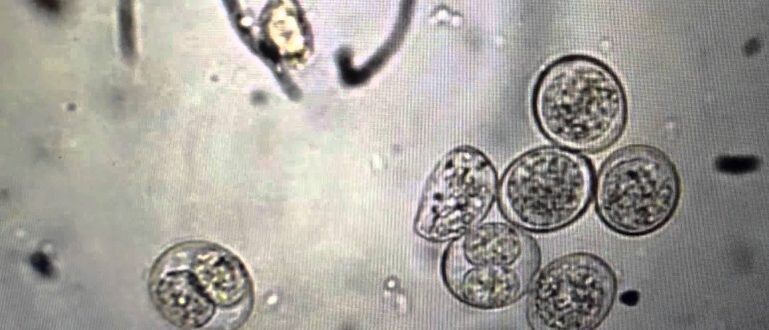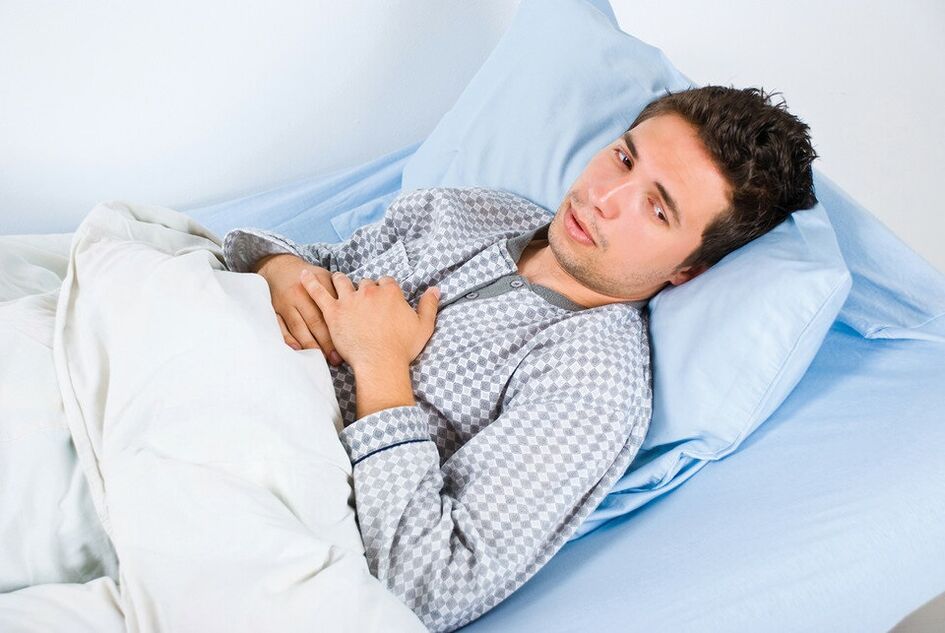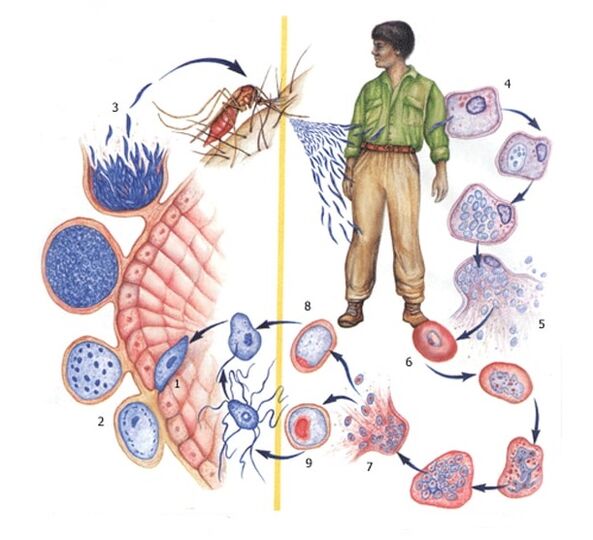
There are as many as 15, 000 species of the simplest organisms living in the earth's water bodies, soil and air. Some of them are the oldest inhabitants on our planet. In the millions of years since the first organism appeared, most protozoa have hardly changed. But they learned to adapt well to the new living conditions and find a way to survive. One of the most obvious ways of these organisms has become parasitic, including in the human body.
parasitic
This is a complex relationship between two organisms. One parasite uses another organism as a habitat or food resource.
The organism in which the parasite lives is called the host. When the parasite goes through its entire development cycle in and in between, it can be permanent when the pathogen only passes through a certain stage of the life cycle.
Parasitism between protozoa is an interaction that not only involves survival and parasitism at the expense of another animal, but also poses a threat to the life of the host, because many types of parasites can cause humans, livestock and other animalsSerious illness. crop.
The simplest human parasites select almost all organs and systems of the human body. They develop very actively and sometimes live in them for many years. This symbiosis leads to the chronicization of the disease and the reduction of the effectiveness of the treatment process.
Ways to enter the human body:
- Through hands and mouth
- Through the skin;
- touch;
- Mother-to-child transmission;
- Bitten by insects or animals;
Comprehensive science to study parasite phenomena, parasite biology and its distribution, diagnosis, treatment and prevention of parasitic diseases.
The simplest pathogenic parasites that cause various forms of disease can be found almost everywhere. These are fresh and salt water, soil, various household items and household items, and public places. Protozoan infection is called protozoan or protozoan infection.
What is the simplest human parasite
The human body, like the body of any more or less large animal, is a very attractive object of parasitic life. In addition to protozoa, multicellular parasites (worms) can also inhabit the human body.
Depending on the habitat, the simplest species can be endogenous (living in the human body) or exogenous (choosing the skin as the habitat). Sometimes, as they develop, the parasites pass through the body, choosing the habitat that is most suitable for a particular stage of development.
The existence of microscopic size and primitive structure allows the simplest parasites to survive and reproduce successfully under the most difficult conditions. All representatives of this species have a structure composed of single cells filled with cytoplasm and intracellular fluid, in which all metabolic processes take place with the participation of organelles (structures that perform various functions to maintain life activities)
Motor functions can be performed by flagella, cilia and pseudopodia for this purpose. The main process (food) is carried out in several ways:
- Swallow with cellular mouth;
- Flow with pseudopods;
- Absorbed by the surface of the membrane.
Adverse conditions can be a signal for the formation of cysts that are resistant to the external environment of the membrane. They are necessary for the simplest human parasites to transfer from one host to another, and can keep prisoners in the parasites for years.
Genital cysts are characterized by the formation of a thin temporary shell, which is necessary for the short-term division of protozoa.
important!The simplest human parasites are the pathogens of protozoan infections: giardiasis, trichomoniasis, sleeping sickness, amoebic dysentery, and malaria.
Types of protozoan parasites
According to the way of reproduction and exercise, and the nature of nutrition, the simplest human parasites mainly fall into four categories:
Flagellates
For example, lamella, Leishmania, Trichomonas, Trypanosoma. They have an elongated oval or pear-shaped body. They can have 1 to 8 slender cytoplasmic flagella, composed of the finest fibrils. They move forward with their flagella, as if screwed into the space in front of them. They eat by absorbing readily available nutrients and absorbing them through membranes. In most cases, it reproduces by simply dividing into two daughter cells. Flagellates can live in groups of up to 10, 000 individuals.
Sporozoites
For example, Plasmodium malaria, Toxoplasma gondii. For the representative of this protozoan, a very complicated development path is its characteristic: from the carrier into the human blood, and then into the liver, where the parasite reproduces and affects red blood cells. Reproductive toxins can cause disease in the human host. For the next development cycle, the pathogen must enter the host again, where the maturation of male and female cells and the formation of spores occur. After maturation, the spores are destroyed and the parasite enters the host again. The cycle keeps repeating.
Ciliates
For example, Balatidia. For ciliates, movement with the help of cilia is its characteristic. There are two nuclei in body cells: the large nucleus controls all life processes, and the small nucleus plays a major role in the existence of protozoa. Reproduction is carried out by dividing the cell in half. For most representatives of the species, this happens every day, sometimes several times a day. Food enters a special cavity (cell port) through the movement of cilia, where it is processed by the digestive juice in the cell, and the undigested residue is excreted from the body.
coding
For example, amoeba is dysentery. It has no fixed shape and forms many pseudopods, which move and grab food with the help of pseudopods. It is multiplied by simple division. It can exist in many forms: tissue, lumen, anterior capsule. This tissue form only exists in the patient's intestines. The rest of the tables can also be found in the host's body.
important!The original structure, the formation of cysts, the simplest method of reproduction, and microscopic size, all these factors allow the simplest parasites to invade the most protected tissues of the human body and become serious and sometimes difficult to diagnose without adverse effects. Pathological conditions.
What diseases can protozoan parasites cause?

In addition to the above factors, the parasitic lifestyle of the simplest microorganisms is also promoted by their anaerobic respiration capacity, although many microorganisms can use dissolved oxygen.
Diseases caused by protozoan parasites include:
malaria
The main symptoms are fever, joint pain, vomiting, anemia, and convulsions. The spleen may be enlarged. Malaria is characterized by the recurrence of the disease, with periods of rest and deterioration. According to the type of pathogen, the form is divided into: three days, four days and tropical. This disease is common in Africa and South Asia. For centuries, as it is today, the main treatment has been quinine, a medicine made from cinchona bark. Despite the creation of synthetic analogues, deaths from infection occurred in areas without access to modern medical services.
Amoebiasis (dysentery amoebiasis)
It is caused by the simplest dysentery sarcode parasite amoeba. Infections can be intestinal and parenteral (developing in the liver). 7-10 days after infection, the first symptoms appear: abdominal pain, weakness, low fever (up to +37. 5°C). About 10% of people may experience severe diarrhea with traces of blood and mucus. Every third of the infected people will have a fever. It is characterized by enlarged liver and, in some cases, liver abscess. If treatment is not started on time, prolonged diarrhea can cause dehydration, weakness and consumption of the patient's body. The outbreak of this disease is typical in countries with hot climates.
Giardiasis
This disease is caused by the simplest species of flagellates. These parasites have 4 pairs of flagella and a sucker, which are attached to the inside of the small intestine. After infection, symptoms will appear: upper abdominal pain and bloating, rumbling and nausea, interruption of normal intestinal function, skin lesions (atopic dermatitis), abnormal gallbladder function, general weakness and decreased strength, weak appetite and sleep. Giardiasis is widely distributed in hot climate regions in Asia, Africa and Latin America.
Leishmaniasis
This disease is caused by the flagellum Leishmania. The main symptom of skin and mucocutaneous leishmaniasis is skin damage in the form of ulcers. For mucosal skin forms, edema and deformation may occur. If the respiratory tract is involved, in rare cases, it can be fatal. Visceral type is characterized by hepatosplenomegaly, fever and anemia. The disease is common in 88 countries, mainly in tropical and subtropical climates.
Trichomoniasis
The disease is caused by the Trichomonas parasite of the flagellum class. The genitourinary system is affected. The main symptoms of women are itching and burning, congestion of the external genitalia, and an unpleasant odor in secretions. Sometimes, they may feel uncomfortable during sexual intercourse and urination. In men, in most cases, the disease is asymptomatic, sometimes painful during urination and discharge, and symptoms of prostatitis may appear.
Foreskin disease
The pathogen is a parasite from the balantidia class of ciliates. The typical symptoms are abdominal pain, diarrhea and tongue coating. In acute cases of the disease, the temperature rises and general signs of poisoning are possible. Infections can also be chronic, with intermittent remission and worsening. In complicated cases, bowel perforation and peritonitis are possible.
Toxoplasmosis
This disease is caused by the toxoplasma parasite of Toxoplasma gondii, which is a spore parasite. The characteristic symptoms of the disease are damage to the eyes, nervous system, heart muscle, enlarged lymph nodes, liver and spleen. It is mainly done in a chronic form. Usually, the primary infection is easy to pretend to be the common ARVI. After that, immunity will always appear and it is impossible to get infected again. The biggest danger is to the fetus during pregnancy: if the child survives, the nervous system and eyes will be severely damaged.
Sleeping sickness
This disease is caused by Trypanosoma Gambia or Rhodesian Trypanosoma, the simplest parasite in the flagella species. The characteristic signs of the first stage are fever, headache, and joint pain. After 7-20 days, the second stage of the disease begins: disturbances in perception of the surrounding world, disturbances in motor coordination, numbness, and sleep disturbances begin to appear. The outbreak of the disease is localized in certain areas of tropical Africa, which is the habitat of the main vector of the tsetse fly infection;
Chagas disease
The pathogen is a parasite from the genus Klebsiella. The main symptoms are fever, swollen lymph nodes, headache, and swelling at the bite site. In the initial stage, there may be no signs of disease. After 8-12 weeks, 30-40% of patients may begin to experience secondary symptoms: enlarged ventricles, dilated esophagus, and large intestine. The second stage of the disease can last 10-30 years after infection. This infection is most common in Latin America.
important!If the basic hygiene and personal hygiene rules are not followed, most of the simplest parasites will enter the human body.
Path of infection
Any microorganism can penetrate into the human body through the skin or natural openings. For most protozoan parasites found in the environment, the methods of human infection are limited to the four most common ones:
- Contact and family. This route of infection can be used for the simplest organisms, violating hygiene and personal hygiene rules. After all, when most microorganisms spread from the body of one host to the body of another host, they will form cysts and remain in this state until they enter a favorable environment, in other words, enter the human body. Infection can happen at any time: shaking hands, using other people's household items (towels, sheets, plates), washing hands with dirty water (in a pond);
- Fecal mouth (giardiasis). In this case, infection occurs when the parasite leaves the intestine with feces or vomit. If the hygiene rules are not followed, the parasites will enter the water, food or hands of the new host and enter the body. Improperly cleaned vegetables and herbs can also be a source of infection. For children, they can get their hands dirty after playing in a sandbox or playing with pets;
- Through contaminated food (toxoplasmosis). The meat of most animals, especially the meat of wild animals, may contain cysts of protozoan parasites. If the heat treatment is insufficient, it will enter the human body. Dairy products that have not passed sanitary control and raw fish that have not been sufficiently heat-treated may also be infected;
- Contagious (malaria, sleeping sickness). Infection occurs through the spread of pathogens through the saliva of the carrier when bitten. The disease is directly transmitted by infected insects to susceptible organisms.
In addition to the main infection method, infection can also occur in a variety of ways, which are less common:
- Through the placenta, protozoan parasites enter the fetus from the infected mother through the placenta;
- Blood contact when parasite-infected blood enters the patient's body (during medical procedures, anesthetic injections, during sexual intercourse);
- Sexual infection occurs only through sexual contact.
prevention
The prevention of infection with protozoan parasites first includes compliance with all hygiene and hygiene rules. You can rule out the possibility of parasite infection by following some of the following recommendations reasonably:
- Heat treatment of meat, dairy products and fish products is sufficient (heat treatment system in accordance with technical regulations). Pay special attention to products that have not passed sanitary control;
- Wash fruits, vegetables, berries and herbs thoroughly, preferably with boiling water. If heat treatment is not possible, especially for feeding children, it is best to peel them;
- Regular physical examinations, especially if infection with protozoan parasites is suspected;
- Stick to a sexual partner and refuse to take drugs;
- Specific measures can be taken to prevent insect bites and infections: use drugs to eliminate mosquitoes, mosquito nets and insect repellents, eliminate genetically modified mosquitoes (resistant to malaria), and develop vaccines.
important!What is very important in preventing any infection (including the simplest human parasites) is the body's resistance level. After all, if the cyst is in a disadvantaged condition, that is, lack of nutrients or immune cells constantly attack foreign objects, then the parasite will either die or leave the host body.
Many foods are natural immune stimulants (garlic, ginger, broccoli, carrots, green tea). If eaten in a balanced way, they can provide valuable help for the body to strengthen immunity.
In addition, some products have a negative impact on the growth and reproduction of protozoa, especially those that settle in the digestive tract: rice and barley porridge, dried fruits, roasted apples, vegetable oil, stews. When treating parasites, it is necessary to limit or completely exclude the products that trigger the fermentation process: baked goods and sugar.
At present, the pharmaceutical industry provides many expensive antiparasitic drugs. However, their effective use can only be achieved by combining preventive measures and adherence to a certain diet, and their ingredients can be consulted by qualified experts.
Don't forget the folk remedies that have passed the test of time and passed down from generation to generation. In the case of a combination of all methods and methods under the supervision of a doctor, the chance of parasites is small.
in conclusion

At the beginning of the 21st century, mankind has made great achievements in the development of parasitology. People who need help and treatment today are always happy to receive information about new discoveries about specific drugs.
In many countries, the simplest human parasites are still a serious problem, and there are still many shortcomings in the medical and social development of these countries. There are many more places on our planet where malaria, sleeping sickness, leishmaniasis and many other diseases are rampant. People wait and hope that everyone has the opportunity to live without disease.
The parasitic diseases of our time are related. They require social interaction in all areas of human life. They are aimed at improving people’s medical care, complying with personal and public health rules and norms, taking preventive measures, sanitation and education, and sanitation of pathogens. The natural foci of organisms.
At present, many countries in the world are conducting various scientific researches in the field of parasitology:
- Develop scientific basis and methods for monitoring infectious diseases and parasitic infections;
- To study the biological characteristics of major diseases caused by protozoan parasites and the variability of pathogens;
- Quality control and environmental safety of meat and fish products;
- Carry out basic research to study the development of parasitic disease pathogens, their genetic variability, and ecology.




























